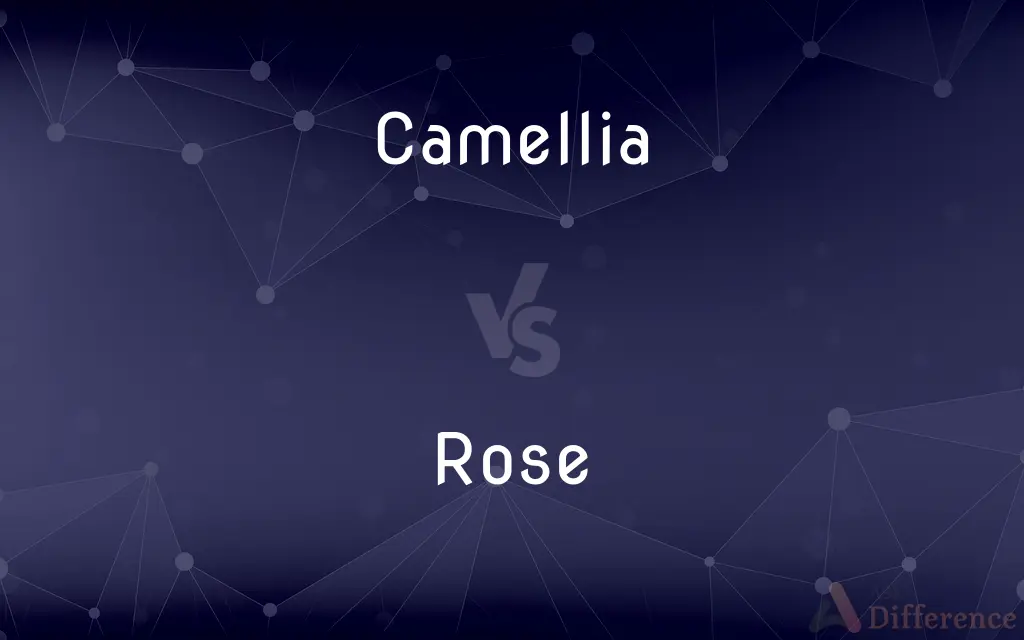Camellia vs. Rose — What's the Difference?
By Maham Liaqat & Fiza Rafique — Updated on March 18, 2024
Camellia is a glossy-leaved evergreen plant with roselike blooms, thriving in partial shade, whereas roses are a diverse group of thorny plants, known for their fragrant, layered flowers, favoring full sun.

Difference Between Camellia and Rose
Table of Contents
ADVERTISEMENT
Key Differences
Camellias are known for their broad, glossy leaves and large, beautiful flowers that can resemble roses, blooming primarily in cooler months, from fall to spring. These evergreen shrubs or small trees thrive in partial shade and well-drained, acidic soil, making them popular in woodland gardens. On the other hand, roses are characterized by their fragrant, often multilayered flowers, available in a wide range of colors and sizes, blooming from late spring to fall. They prefer full sun and well-drained soil, and their cultivation is widespread due to their iconic status in gardens and floral arrangements.
While camellias are generally more shade-tolerant and have a more consistent leaf appearance, roses boast a greater diversity in flower types and colors, from singles to full doubles, and are notable for their often prickly stems. Camellias typically require less maintenance once established, being resistant to most pests and diseases, whereas roses are known for their need for regular care, including pruning, heading, and monitoring for diseases like black spot and pests such as aphids.
The symbolic meanings of these plants also differ; camellias are often associated with admiration, perfection, and gratitude in various cultures, while roses carry a wide array of meanings based on their color, including love, beauty, and honor. The camellia's association with tranquility and understated elegance contrasts with the rose's embodiment of deep emotional connections and celebrations.
In terms of applications, both camellias and roses are popular in landscaping for their aesthetic appeal. However, roses have a broader use in perfumery, culinary arts, and medicine, thanks to their aromatic oils and edible petals, whereas camellias are prized mainly for their ornamental value, though some species like Camellia sinensis, the tea plant, have significant economic and cultural importance.
Comparison Chart
Bloom Time
Fall to Spring
Late Spring to Fall
ADVERTISEMENT
Sunlight Preference
Partial Shade
Full Sun
Soil Preference
Acidic, Well-Drained
Well-Drained
Maintenance
Lower maintenance
Requires regular pruning and care
Flower Characteristics
Resembles roses, less variety
Wide range of colors and forms, often fragrant
Symbolism
Admiration, Perfection
Love, Beauty, depending on color
Uses
Ornamental, some species for tea
Ornamental, culinary, perfumery, medicinal
Foliage
Evergreen, glossy leaves
Deciduous or semi-evergreen, varied leaf texture
Disease and Pest Resistance
Generally more resistant
Prone to pests and diseases like black spot
Compare with Definitions
Camellia
A plant known for its bright and large flowers.
The pink camellias added a splash of color to the winter landscape.
Rose
A thorny plant with fragrant, multilayered flowers.
The rose garden was in full bloom, filling the air with fragrance.
Camellia
Belongs to the tea family, with some species used to produce tea.
Camellia sinensis leaves are harvested to make green tea.
Rose
Used in perfumery, culinary arts, and as medicinal plants.
Rose oil is a prized ingredient in high-end perfumes.
Camellia
An evergreen shrub with glossy leaves and rose-like flowers.
The camellia bush bloomed beautifully in the shaded part of the garden.
Rose
Prone to pests and diseases, requiring regular care.
Regular pruning helps keep rose bushes healthy and blooming.
Camellia
Symbolizes admiration and perfection in many cultures.
He gave her a bouquet of camellias to express his admiration.
Rose
Comes in numerous varieties and colors, each with symbolic meanings.
Red roses are traditionally given as a symbol of love.
Camellia
Thrives in acidic soil and partial shade.
Camellias are ideal for the shaded sections of the garden where other plants struggle.
Rose
Requires full sun and well-drained soil for optimal growth.
The roses thrived once planted in the sunny part of the yard.
Camellia
Camellia (pronounced or ) is a genus of flowering plants in the family Theaceae. They are found in eastern and southern Asia, from the Himalayas east to Japan and Indonesia.
Rose
A rose is a woody perennial flowering plant of the genus Rosa, in the family Rosaceae, or the flower it bears. There are over three hundred species and tens of thousands of cultivars.
Camellia
Any of several evergreen shrubs or small trees of the genus Camellia native to eastern Asia, especially C. japonica, having shiny leaves and showy roselike flowers that are usually red, white, or pink.
Rose
Any light pink wine, coloured by only brief contact with red grape skins
A local rosé wine
A glass of rosé
Camellia
Any plant of the genus Camellia, shrubs and small trees native to Asia; Camellia japonica is the most popular as a garden plant; Camellia sinensis is the tea plant.
Rose
Make rosy
A warm flush now rosed her hitherto blue cheeks
Camellia
An Asiatic genus of small shrubs, often with shining leaves and showy flowers. Camellia Japonica is much cultivated for ornament, and Camellia Sassanqua and Camellia oleifera are grown in China for the oil which is pressed from their seeds. The tea plant is now referred to this genus under the name of Camellia Thea.
Rose
Any of numerous shrubs or vines of the genus Rosa, having prickly stems and pinnately compound leaves, widely cultivated for their showy, often fragrant flowers.
Camellia
An ornamental greenhouse shrub (Thea japonica) with glossy evergreen leaves and roselike red or white double flowers.
Rose
The flower of any of these plants.
Camellia
Any of several shrubs or small evergreen trees having solitary white or pink or reddish flowers
Rose
Any of various other plants, especially one having similar flowers.
Rose
A member of the rose family.
Rose
A dark pink to moderate red.
Rose
An ornament, such as a decorative knot, resembling a rose in form; a rosette.
Rose
A perforated nozzle for spraying water from a hose or sprinkling can.
Rose
A form of gem cut marked by a flat base and a faceted, hemispheric upper surface.
Rose
A gem, especially a diamond, cut in this manner.
Rose
A rose window.
Rose
A compass card or its representation, as on a map.
Rose
Roses That which is marked by favor, success, or ease of execution
Directing this play has been all roses since the new producer took over.
Rose
A light pink wine made from purple grapes, with the skins being removed from the juice during fermentation as soon as the desired color has been attained.
Rose
Of the color rose.
Rose
Relating to, containing, or used for roses.
Rose
Scented or flavored with or as if with roses.
Rose
Past tense of rise.
Rose
A shrub of the genus Rosa, with red, pink, white or yellow flowers.
Rose
A flower of the rose plant.
Rose
A plant or species in the rose family. (Rosaceae)
Rose
Something resembling a rose flower.
Rose
(heraldry) The rose flower, usually depicted with five petals, five barbs, and a circular seed.
Rose
A purplish-red or pink colour, the colour of some rose flowers.
Rose
A round nozzle for a sprinkling can or hose.
Rose
The usually circular base of a light socket in the ceiling, from which the fitting or chandelier is suspended.
Rose
Any of various large, red-bodied, papilionid butterflies of the genus Pachliopta.
Rose
(mathematics) Any of various flower-like polar graphs of sinusoids or their squares. Category:en:Curves
Rose
A graph with only one vertex.
Rose
Alternative spelling of rosé
Rose
To make rose-coloured; to redden or flush.
Rose
To perfume, as with roses.
Rose
Past participle of rise
Rose
Having a purplish-red or pink colour. See rosy.
Rose
A flower and shrub of any species of the genus Rosa, of which there are many species, mostly found in the morthern hemispere
Rose
A knot of ribbon formed like a rose; a rose knot; a rosette, esp. one worn on a shoe.
Rose
A rose window. See Rose window, below.
Rose
A perforated nozzle, as of a pipe, spout, etc., for delivering water in fine jets; a rosehead; also, a strainer at the foot of a pump.
Rose
The erysipelas.
Rose
The card of the mariner's compass; also, a circular card with radiating lines, used in other instruments.
Rose
The color of a rose; rose-red; pink.
Rose
A diamond. See Rose diamond, below.
Rose
To render rose-colored; to redden; to flush.
Rose
To perfume, as with roses.
Rose
Any of many plants of the genus Rosa
Rose
Pinkish table wine from red grapes whose skins were removed after fermentation began
Rose
A dusty pink color
Rose
Having a dusty purplish pink color;
The roseate glow of dawn
Common Curiosities
What are camellias?
Camellias are evergreen shrubs with glossy leaves and large, rose-like flowers, popular for their ornamental value and some species for tea production.
Can both camellias and roses be used in landscaping?
Yes, both are popular in landscaping for their aesthetic appeal, but roses offer a broader range of colors and fragrances.
What do camellias symbolize?
Camellias symbolize admiration, perfection, and gratitude in various cultures.
What are roses?
Roses are a diverse group of plants known for their fragrant, often multilayered flowers, used widely in gardens, perfumery, and culinary contexts.
How do camellias and roses differ in care requirements?
Camellias generally require less maintenance and thrive in partial shade, while roses need more care, including regular pruning, and prefer full sun.
Are camellias evergreen?
Yes, camellias are evergreen, retaining their glossy leaves year-round.
How do the flower forms of camellias and roses compare?
Camellia flowers can resemble roses but with fewer varieties, whereas roses come in a wide range of forms and colors.
What do roses symbolize?
Roses carry a wide range of meanings, including love, beauty, and honor, which can vary based on their color.
Do roses require full sun?
Yes, roses perform best in full sun, which helps promote healthy blooms.
Is the camellia flower edible?
While camellias are not commonly used in cooking, the leaves of Camellia sinensis are used to produce tea.
Are camellias resistant to pests and diseases?
Camellias are generally more resistant to pests and diseases compared to roses.
When do roses bloom?
Most rose varieties bloom from late spring to fall, with some varieties offering repeat blooms throughout the season.
When do camellias bloom?
Camellias typically bloom from fall to spring, providing color in cooler months.
Can both plants be grown in pots?
Both camellias and roses can be grown in pots, but they require appropriate soil, watering, and placement to thrive.
Can roses be used in cooking?
Yes, some rose varieties have edible petals and are used in culinary dishes and for making rose water.
Share Your Discovery

Previous Comparison
Voucher vs. Warrant
Next Comparison
Clink vs. ChinkAuthor Spotlight
Written by
Maham LiaqatCo-written by
Fiza RafiqueFiza Rafique is a skilled content writer at AskDifference.com, where she meticulously refines and enhances written pieces. Drawing from her vast editorial expertise, Fiza ensures clarity, accuracy, and precision in every article. Passionate about language, she continually seeks to elevate the quality of content for readers worldwide.














































